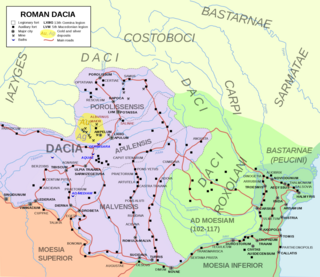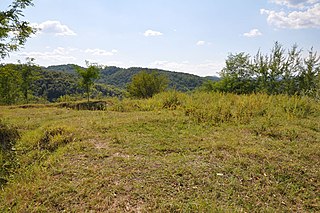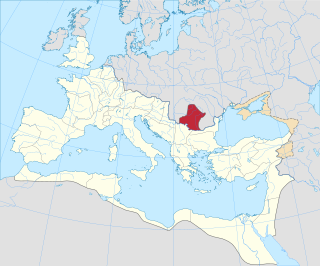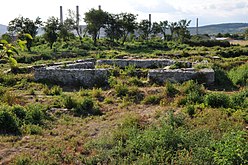
The Burs were a Dacian tribe living in Dacia in the 1st and 2nd centuries A.D., with their capital city at Buridava.

Porolissum was an ancient Roman city in Dacia. Established as a military fort in 106 during Trajan's Dacian Wars, the city quickly grew through trade with the native Dacians and became the capital of the province Dacia Porolissensis in 124. The site is one of the largest and best-preserved archaeological sites in modern-day Romania. It is 8 km away from the modern city of Zalău, in Moigrad-Porolissum village, Mirsid Commune, Sălaj County.

Trajan's Second Dacian War was fought between 105 and 106 because the Dacian king, Decebalus, had broken his peace terms with the Roman Emperor Trajan from the Trajan's First Dacian War.

Located in Roman province of Dacia, present-day Romania, the Limes Porolissensis was a frontier of the Roman empire in Dacia Porolissensis, the northernmost of the three Dacian provinces. It was a defensive line dating from the 2nd century AD after the Conquest of Dacia. The frontier was a complex network of over 100 observation towers, fortlets, walls and forts disposed in a line over 200 km from the Apuseni Mountains to the Eastern Carpathians, following the highland chain of the Meseș Mountains.

The Moesian Limes is the modern term given to a linked series of Roman forts on the northern frontier of the Roman province of Moesia along the Danube between the Black Sea shore and Pannonia and dating from the 1st century AD. It was the eastern section of the so-called Danubian Limes and protected the Roman provinces of Upper and Lower Moesia south of the river. The eastern section is often called the limes Scythiae minoris as it was located in the late Roman province of Scythia Minor.

The Limes Alutanus was a fortified line of the earlier eastern border of the ancient Roman province of Dacia and built by the Roman emperor Hadrian to stop invasions and raids from the east.

Acidava (Acidaua) was a Dacian and later Roman fortress on the Olt river near the lower Danube. The settlements remains are located in today's Enoşeşti, Olt County, Oltenia, Romania.

Buridava (Burridava) was a Dacian town situated in Dacia, later Dacia Apulensis, now Romania, on the banks of the river Aluta, now Olt.

Arutela was an ancient Roman fort in the Roman province of Dacia today near the town Călimănești. It lies on the left bank of the Olt River. It was part of the Roman frontier system of the Limes Alutanus,

Praetorium II (Racovița) was a fort in the Roman province of Dacia near the present village of Racovița, Vâlcea. It was built in the middle of the 3rd century, part of the Roman frontier system of the Limes Alutanus along the Olt (river) and was the largest fort in the mountain area of the Limes.

The castra of Bulci was a fort in the Roman province of Dacia located on the western side of defensive line of forts, limes Daciae. Its ruins are located in Bulci.

Caput Stenarum was a fort in the Roman province of Dacia in the 2nd century AD. It is located 700 m east of the village Boița in Romania at the northern exit of the Olt gorge.
Morisena was a castra in the Roman province of Dacia. Morisena was a Roman auxiliary camp and part of the outline in the western fortress chain of the Dacian Limes. It was located within the modern municipality of Cenad, Romania.

The castra of Aradul Nou was a fort in the Roman province of Dacia, located on the western side of the defensive line of forts, limes Daciae. It is situated near Arad, Romania.

The castra of Cincșor was a fort in the Roman province of Dacia in the 2nd and 3rd centuries AD and part of the frontier system of the Limes Alutanus.

Praetorium I (Copăceni) was a fort in the Roman province of Dacia near the present village of Copăceni, Racovița, Vâlcea, Romania. It was part of the Roman frontier system of the Limes Alutanus along the Olt (river). It was built in 138 and reinforced with two towers two years later.

Potaissa was a legionary fortress and later a city in the Roman province of Dacia, located in today's Turda, Romania.

Roman Dacia was a province of the Roman Empire from 106 to 271–275 AD. Its territory consisted of what are now the regions of Oltenia, Transylvania and Banat. During Roman rule, it was organized as an imperial province on the borders of the empire. It is estimated that the population of Roman Dacia ranged from 650,000 to 1,200,000. It was conquered by Trajan (98–117) after two campaigns that devastated the Dacian Kingdom of Decebalus. However, the Romans did not occupy its entirety; Crișana, Maramureș, and most of Moldavia remained under the Free Dacians.

Castra of Rădăcinești was a fort in the Roman province of Dacia near the Limes Alutanus on the west bank of the Olt River.

The Dacian Limes is the generic modern term given to a collection of ramparts and linked series of Roman forts on the frontiers of the Roman province of Dacia dating from the 1st century AD. They ran for about 1,000 km and included the:




















